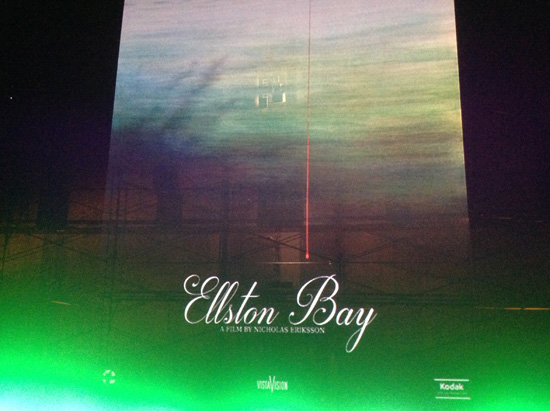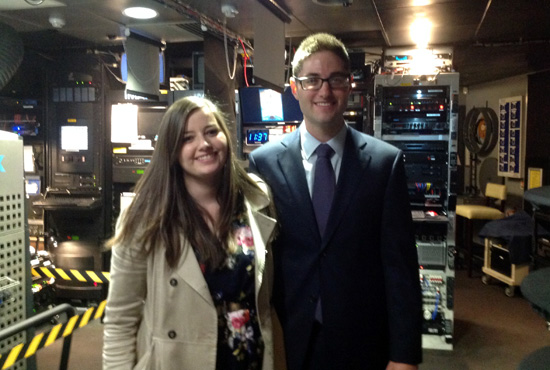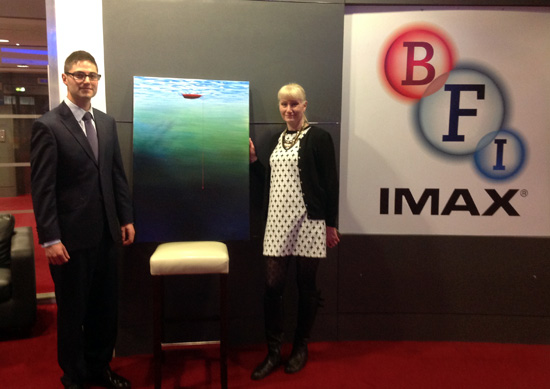The Man Who Could Work Miracles - in VistaVision |
Read more at in70mm.com The 70mm Newsletter |
| Written and photographed by: Mark Lyndon, in70mm.com, London Reporter | Date: 07.06.2018 |
 BFI
IMAX screen in London, Saturday 14th April, 2018, 10 am. BFI
IMAX screen in London, Saturday 14th April, 2018, 10 am.We had just seen a very interesting short film called "Ellston Bay", filmed in VistaVision. It was based on an eerie short story by that master of atmospheric horror HP Lovecraft and RH Barlow. "Ellston Bay" went down quite well with a reasonably sized but enthusiastic audience. It was essentially a showreel. Nick is hoping to get backing for a feature. It was a DCP from a 6k scan of the VistaVision negative. The Hasselblad lenses made it look razor sharp with a good immersive effect, not only on the beach but also interior shots. The underwater photography was superb. Nick crammed a lot into that 15 minute show reel and I wished him all the best in his quest to make a full length feature. Now that could well be something. I interviewed the Director Nicholas Eriksson shortly after the screening at the London BFI IMAX Mark Lyndon, in70mm.com |
More in 70mm reading: "Ellston Bay" - in VistaVision The Making of ‘Ellston Bay’ Internet link: • kickstarter.com • facebook.com • ellstonbay.com • nicholaseriksson.com Nicholas Eriksson Director of Photography +44 (0)7858 568 945 Ellston Bay Office 2, The Courtyard 30 Worthing Road Horsham, West Sussex RH12 1SL United Kingdom |
 Director
of "Ellston Bay", Nicholas Eriksson and friend in BFI IMAX
projection room. Director
of "Ellston Bay", Nicholas Eriksson and friend in BFI IMAX
projection room.ML: How did the Project first begin? NE: I became really fascinated by HP Lovecraft's work. He was a Pulp writer in the 1920s and 30s. He was not so acclaimed when he was alive, but certainly after his death, he inspired a lot of directors and storytellers. I have long had a desire to adapt one of his stories. I came across a short story of his. He had collaborated with a writer called RH Barlow to create a story called The Night Ocean. I set to work writing a screenplay with Edward Carter, a writer. What I really loved about the story was the pervasive mood and atmosphere that something is not quite right It is a horror story, written in a more traditional sense of feeling something is not quite right, but not so much playing with blood and gore - the things we used to see in that genre. We tried to make an intelligent genre film that plays with mood and atmosphere. We adapted the original story and found that it didn't quite work. It was a bit too obscure, a bit too abstract. So we went right back to the drawing board and we started again. This time we brought in our own element, but we strived to retain that sense of mood and atmosphere that pervaded the original short story. ML: What is so special about VistaVision? NE: VistaVision is a stunning format. To go back to an earlier question, of being influenced to make "Ellston Bay". I had come to the BFI IMAX a number of times in 2012 and I saw a few films, especially by Chris Nolan as well as "Mission Impossible", that used IMAX Large Format cameras and printed in IMAX 70mm film and I was just blown away by the quality of the final imagery. I had not realised just how stunning it could look. When I had a budget for "Ellston Bay", being a cinematographer and interested in visually playing the story as powerfully as possible; I wanted to use IMAX. I quickly realised that would not be possible. The costs would be huge. The IMAX cameras are not based in the UK. Then I looked at 65mm and again the problem with shooting 65mm in the UK is that the cameras are based in Berlin, in Germany. I remember thinking about those great Alfred Hitchcock films: "North by Northwest", "Vertigo", as well as "The Searchers" and all the great films made in a small period in the late 1950s in VistaVision. The great thing about VistaVision is that is shot in 35mm. The stock is usually available and is processed in the same way as any 35mm rolling stock. It uses double the perforations and is also more suited to my preferred aspect ratio of 1,85:1. The films that blew me away were Large Format Full Aspect Ratio and not wide presentations. I never had the desire to show the final result in 2.35:1. I always wanted it to be large but tall, for the IMAX screen. I did some research and found a company - Camera Evolution in Shepperton that had a couple of VistaVision cameras available. In 2017, I started a very long process of working out how to use them and we went through some really interesting processes to try and make it possible, including using the Hasselblad V-Series lenses, the same lenses used on many IMAX productions. I imported these specialist lenses from Chicago to allow us to mount from Hasselblad to Leica R mounts. They are very unusual, because most mounts used in the industry are PL mounts. We did a series of tests and it was a process of discovery. The actual use of the cameras was very straightforward, like any other camera - very easy to use, a little heavier, a little less ergonomic than a modern camera, but generally speaking; it was absolutely fine. The main thing is time, because you need to reload more often. You have thirty feet left on the magazine, when normally, it would be more like fifty feet. On this format, it's not worth the hassle to reload. It's a wonderful format. I wanted to prove to myself that this format is viable, that there is no reason why it cannot be used today. |
|
 Director
of "Ellston Bay", Nicholas Eriksson and friend at the BFI IMAX. Director
of "Ellston Bay", Nicholas Eriksson and friend at the BFI IMAX.ML: For Principal Photography? NE: For Principal Photography, absolutely. I love film anyway and use it all the time. I thought that if I make my own project, I could back up how I feel. There is a stamina required for doing your own personal project. When you go through the hard times and nothing is working and you are striving to find a way to make it work; that somehow drives a crazy desire to use this wonderful format. It gives you the passion to press through to do something you have never done before. There is an element that makes it feel that it's not just another short film. It's hard because it's not meant to be easy. It's a hard process, it always is in VistaVision. ML: Having now seen it, I think it is a masterpiece. It looked like the ambition was to produce a work of art, not simply entertainment and only true film would be good enough to create a work of art. NE: My concern was for it to be intelligent - the intelligence I could discern from watching Hong Kong genre films. I love genre films. To make a good film was the biggest reason as well. My main concern, more than anything else, was to tell a story. I knew that being a cinematographer, that there would be a temptation. My natural instinct would be to create a series of beautiful images, but not necessarily to tell the greatest story; because I am more motivated by imagery than I am by stories. My aim was never to make a work of art, it was to make an intelligent genre film that you could enjoy on a surface level, watch and enjoy and not understand; then also if you looked further, you looked deeper; there is more there to be found. There is a reason for every scene in the film. There is nothing superficial in the film. There is a meaning behind everything you see and I hope that on multiple viewings, if someone had the desire to watch it again and they have questions they want answered, they can see things that they did not see before. Growing up, a lot of my favourite cinema was and still is, a very visual form of story telling. So, whenever I can say something by pictures, rather than words: I will always go down that route. One day, I found in the post production of the film that we had dialogue and before that even more dialogue and I quickly confirmed my feelings that when there is too much dialogue, it saps the mood and atmosphere. It's the look and reflective nature of the visuals that matters. My hope is that they will take from the mood that there is something not quite right. Something is just off. What is it? You can't put your finger or what it is. I wanted to avoid being wordy. My original concept was quite different. Had this been longer, i.e. a feature film, the pacing would have been much slower. I like the idea that in creepy horror films, typically, there is a lot of smoke and mirrors, dark and dingy and you can't quite see what's happening. I also like the idea of the opposite, so everything is in the crispest, cleanest detail. You can see that the ocean has the standard look and you still cannot glean any clue as to what might be going on. I quite like the idea that like "The Creature", you can see it, but you can't see it. That was something I would try and keep in the story. It changed a lot, because it needed to be much more confined and it actually ends up being quite snappy and cutting quite quickly. |
|
 Director
of "Ellston Bay", Nicholas Eriksson and in70mm.com's Mark Lyndon posing with
"Ellston Bay" poster in BFI IMAX
foyer. Director
of "Ellston Bay", Nicholas Eriksson and in70mm.com's Mark Lyndon posing with
"Ellston Bay" poster in BFI IMAX
foyer.ML: Would you say that combining the role of Director and DP helps the production process? NE: It's funny, when I work as a DP, I would never impose my ideas on a Director. It's their material. It would be quite hypocritical for me to do my own thing. As a Director, first of all. I didn't really want to negotiate or compromise on imagery, not because I think I'm a great DP, but because I knew exactly what I wanted. I needed to do that for myself, rather than negotiate. The VistaVision system required a huge amount of work and with a low budget project like this, the amount of time and commitment of a DP in scheduling and ensuring that everyone is on the same page and issues with the camera is a massive investment in time and work. It helped the project enormously that my home town was in Devon. I know the area really, really well. It's an amazing advantage knowing the tides and weather, how the environment changes. It was more a case of knowing what I wanted to achieve and not allowing compromise in using VistaVision. There is no point in using VistaVision, otherwise. The vast majority of the film is shot on Kodak Vision3 50D 5203. The underwater sequences were shot on Kodak Vision3 250D 5207. It is a very sensitive stock. I would want to squeeze every last detail from the format and so I made things unnecessarily difficult for myself, but for the right reasons as in the daytime interior shoot. We didn't have a big lighting package, so I had to rely on natural light. The lenses would only go to stop 2.4 so I stuck with the fastest stock and it was a case of trying to squeeze every ounce of detail from that negative. ML: Essentially Ellston Bay is a drama in a seascape. Were you going for painterly look? NE: Yes, I guess so, the original concept was more like that, more painterly in a sense that you are looking at a wide frame on a giant screen. In reality in the end, because of the length of the film, we found we had to quick cut much more. For instance there is a scene in the film with action in the ocean. If that was in a feature, I would drag it out for a minute, whereas in the film it is five seconds. ML: If you had enough backing, could you expand to a feature one day? NE: One day, I would love to expand the idea. It would actually work better as a feature film, than it does as a short. One of its weaknesses is that there is too much going on. It is too squashed. But it is always good to have too much going on than too little. Most short films are too long. This one is too short. ML: Would you be looking at an hour and a half running time? NE: I wouldn't want to be bloated or self-indulgent. I would want to tell a story as efficiently and as effectively as possible. In works of fiction I prefer eighty minutes than having an unlimited amount of time. I like the discipline of the 1940s and 1950s films, made in eighty minutes. Get in the cinema, watch the film and then you are done. ML: On behalf of 70mm.com, our Editor Thomas Hauerslev and our readers, I wish you the very, very best and we very much hope that Ellston Bay will become a feature one day in the not too distant future. NE: Thank you. |
|
| Go: back - top - back issues - news index Updated 22-01-25 |
